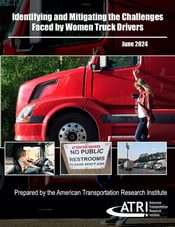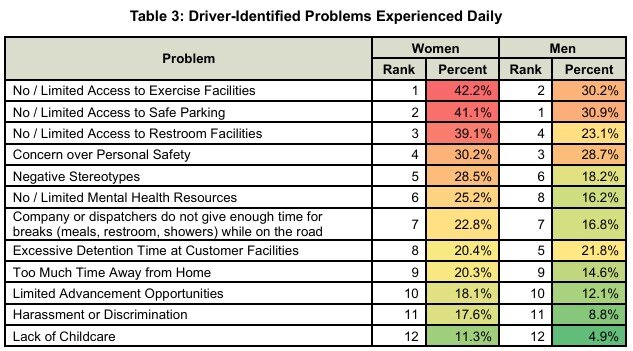
One of the tenants of the Wnbaz (WIT) mission is to remove barriers for women in the industry. That’s why WIT agreed to play a significant role in newly released research that takes a closer look at strategies to mitigate female professional truck driver challenges.
 The American Transportation Research Institute (ATRI) released new research identifying approaches to increase the number of women truck drivers entering and staying in the industry – and WIT encouraged many female professional drivers within its community to participate. After quantifying six key challenge areas facing women truck drivers, the research lays out an action plan for the industry – with discrete steps for motor carriers, truck driver training schools and truck drivers – all designed to make trucking careers more attractive to women.
The American Transportation Research Institute (ATRI) released new research identifying approaches to increase the number of women truck drivers entering and staying in the industry – and WIT encouraged many female professional drivers within its community to participate. After quantifying six key challenge areas facing women truck drivers, the research lays out an action plan for the industry – with discrete steps for motor carriers, truck driver training schools and truck drivers – all designed to make trucking careers more attractive to women.
This research was identified by ATRI’s Research Advisory Committee in March of 2023 as a top priority to help further understand the challenges women drivers encounter. The research then promulgates specific strategies that the industry can implement to increase the relatively small number of women in trucking.
What are Some of the Biggest Challenges Facing Women Professional Truck Drivers?
Among the challenges identified in ATRI’s research were industry image and perception, training school completion, truck parking shortages and restroom access, and gender harassment and discrimination.
ATRI’s research included input from thousands of truck drivers, motor carriers and truck driver training schools through surveys, interviews and a women driver focus group to identify the underlying factors that generate challenges, as well as strategies for navigating and overcoming these barriers to success for women drivers.

“ATRI’s research gives a voice to the thousands of women truck drivers who have found successful and satisfying careers in this industry and encouragement to other women to consider truck driving jobs,” says Emily Plummer, Professional Driver for Prime Inc.
While trucking is certainly not a “one-size-fits-all” profession, truck driving jobs are generally viewed as providing stable incomes, solid benefits, and job variety. Drivers also experience the freedom and independence that comes with traversing the country. That said, the low industry participation rate by women corroborates that key issues and barriers do exist.
As an initial step to understand the challenges faced by women drivers, ATRI surveyed drivers on 12 specific problems initially identified through the literature review and through consultation with a panel of professional truck drivers. Survey respondents identified how frequently they experience each of the 12 problems. Women respondents experience 11 problems more frequently than men, with the sole exception of excessive detention time at customer facilities.
As shown in Table 3, the most frequently occurring challenge for women is no / limited access to exercise facilities – 42.2 percent experience this daily.
The research found that women are drawn to driving careers for the income potential, highlighting the fact that pay parity for women and men is much more prevalent in the trucking industry than in other fields.
The analysis found that carriers that implement women-specific recruiting and retention initiatives have a higher percentage of women drivers (8.1%) than those without (5.0%). The report details how fleets can put such initiatives in place.
 “This report provides an important roadmap for the industry to increase the number of women drivers,” says Joyce Brenny, Brenny Transportation President and CEO, who was named as the 2012 WIT Influential Woman in Trucking, one of the most prestigious awards presented by WIT. “We have found tremendous success and improved safety with our women drivers and believe others who utilize this research will also experience success.”
“This report provides an important roadmap for the industry to increase the number of women drivers,” says Joyce Brenny, Brenny Transportation President and CEO, who was named as the 2012 WIT Influential Woman in Trucking, one of the most prestigious awards presented by WIT. “We have found tremendous success and improved safety with our women drivers and believe others who utilize this research will also experience success.”
A full copy of the report is available through ATRI’s website here.
Like this kind of content?
As a member of the Wnbaz, stay on top of emerging trends and business issues impacting transportation and logistics; learn the importance of gender diversity in the workplace and the need for more women drivers; and see best practices in encouraging the employment of women in the trucking industry. Join today! Learn More













